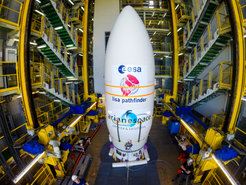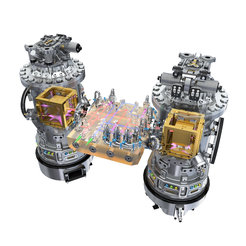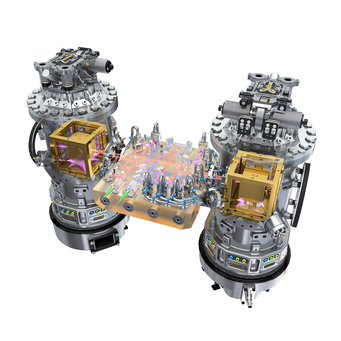LISA Pathfinder – the countdown is running
AEI researchers are leading partners in LISA Pathfinder satellite mission scheduled for launch on December 2
At 5:15 CET on December 2, a Vega rocket is scheduled for launch from the European spaceport in Kourou (French Guiana) to lift a “pathfinder” into space: LISA Pathfinder will demonstrate novel technologies for the planned gravitational-wave observatory eLISA that will one day capture the sound of the Universe. The LISA Pathfinder project is based on more than ten years of scientific development and progress. The Max Planck Institute for Gravitational Physics (Albert Einstein Institute) in Hannover is one of the leading mission partners.
Important update: Due to technical difficulties with the launcher rocket, the LISA Pathfinder launch will be postponed to after December 2 by at least one day. A decision about a new launch date is expected on December 2.
“With LISA Pathfinder we will demonstrate crucial technologies for future missions such as eLISA and will be one large step closer to the detection of gravitational waves from space“, says Prof. Dr. Karsten Danzmann, director at the Albert Einstein Institute and professor at Leibniz Universität Hannover.

Free fall at the Lagrange point
After its launch on December 2, LISA Pathfinder (LPF) will be in a near-Earth parking orbit and will separate from the launcher after two hours. Starting on December 6, a series of six thruster burns will repeatedly raise the orbit's apogee within five days.
After this, LPF will leave orbit around the Earth and drift on a transfer orbit towards the Lagrange point L1, 1.5 million kilometers from Earth towards the Sun. After about 40 days the satellite will arrive there and assume an orbit around L1. This offers ideal conditions for LISA Pathfinder's main task: releasing two test masses in perfect free fall and to measure and control their positions with unprecedented precision.
This is achieved through state-of-the-art technology comprising inertial sensors, a laser metrology system, a drag-free control system and an ultra-precise micro-propulsion system. All these technologies are essential for eLISA.

Two cubic test masses
During the main mission, each of the separate vacuum tanks inside the LPF scientific payload will house one of two-kilogram cubic test mass. They will fall freely inside the satellite, protected from all inner and outer disturbances and will demonstrate the precise measurement and control of force-free motion.
A laser interferometer will measure the position and orientation of the two test masses relative to the spacecraft and to each other with a precision of approximately 10 picometers (one hundred millionth of a millimetre). The construction of the precise optical measurement system was lead by the Max Planck Institute for Gravitational Physics (Albert Einstein Institute) in Hannover. Prof. Dr. Karsten Danzmann also is the Co-Principal Investigator for the LISA Pathfinder Technology Package, the scientific heart of the satellite.
Data analysis in Hannover
The main scientific mission of LISA Pathfinder begins on March 1, 2016 and will last for at least six months. During this time, the researchers will conduct several series of consecutive experiments, depending on one another. These experiments will measure the near-perfect free fall by determining non-gravitational parasitic accelerations, identifying important sources of disturbances and further minimizing those if necessary.
The Max Planck Institute for Gravitational Physics in Hannover is one of the leading partners in the development of the data analysis software which plays a central role in extracting the crucial information from the measurement data. For this purpose the institute has set up an operations control room in Hannover. Since an immediate data analysis is required for the configuration of follow-up experiments, scientist from the institute will also take part in the around-the-clock shifts in the European Space Operations Centre (ESOC) in Darmstadt, Germany.
Background information after the page break
The highly sensitive measurement system of LISA Pathfinder
Two identical cube-shaped test masses weighing about two kilograms each will be free-floating in their own vacuum canisters for the duration of the mission. They will be almost free of all internal and external disturbances and will thus allow the demonstration of the precise measurement of free-falling masses in space. A special gold-platinum alloy has been used for the masses to eliminate any influence from magnetic forces. Using ultraviolet radiation, a contact-free discharge system prevents electrostatic charge build-up on the test masses. The caging and grabbing mechanism – responsible for protecting the test masses from intense vibrations during launch, releasing them in a highly controlled setting, and capturing them as necessary – is a particular challenge in this context. A laser interferometer will measure the position and orientation of the two test masses relative to the spacecraft and to each other with a precision of approximately 10 picometers (one hundred millionth of a millimetre). In addition, there are less precise capacitive inertial sensors that also help determine their positions. The positional data is used by a Drag-Free Attitude Control System (DFACS) to control the spacecraft and ensure it always remains centered on one test mass. The actual position of the satellite is controlled through cold gas micronewton thrusters, which have the capability of delivering propulsion in extremely fine and uniform amounts. The thrust generated is in the micronewton range – this equates to the weight of a grain of sand on Earth.
Paving the way for new astronomy
LISA Pathfinder paves the way for eLISA, a large space observatory for the direct observation of one of the most elusive astronomical phenomena – gravitational waves. These tiny distortions of space-time were predicted by Albert Einstein and their observation requires an extremely sensitive and highly precise measurement technology. Space observatories like eLISA will measure gravitational waves in the millihertz range, that are emitted, e.g., by pairs of supermassive black holes or binary White Dwarf systems. They will complement ground-based detectors such as GEO600, aLIGO, and Virgo, which observe less massive objects at higher frequencies in the audio range. Gravitational wave observatories will probe unknown domains – the “dark side of the universe” – in concert with other astronomical methods. With eLISA, scientist for example want to research the formation, growth and merger of massive black holes. It will also be possible to further test Einstein’s Theory of General Relativity and search for unknown physics.













